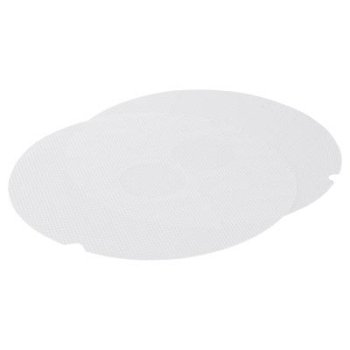 Screen flexes to remove sticky fruits and jerky quickly and easily. Herbs and spices wont fall through tray spokes. Includes 2 screens. Dishwasher safe. U.S.A.
Screen flexes to remove sticky fruits and jerky quickly and easily. Herbs and spices wont fall through tray spokes. Includes 2 screens. Dishwasher safe. U.S.A.Now that we have covered location, soil, and how big you want your garden it is now time to determine what you would like to grow in it. Unfortunately, there isn't a list I can give you since each family has different needs, but as you plant your garden, think carefully about what you will actually do with the harvest, the time you have to preserve if necessary, and what your family likes to eat. If they hate cherry tomatoes, there is no sense in planting them!
Before you go to a nursery and see all those lush beautiful plants and get carried away, make sure you have a plan. Similar to grocery shopping, if you go without a list you will most likely end up buying items you do not need!
Start with you family's favorites, then check the yields on the seed packets to try to determine how much you will need. If you are purchasing plants from a nursery, ask them to help you choose. When deciding what to plant ask yourself:
1. Does my family like it?
2. Do I have the room to grow it?
3. Do I know where in my garden it will go?
4. What am I going to do with the harvest (ie dehydrate, can, freeze etc)
If you are planning on canning, dehydrating, freezing etc, make sure you have adequate supplies and resources for it. If you don't have an extra freezer, it may be difficult to freeze a lot of items. If you don't have a dehydrator, can you borrow one? And if you don't have canning supplies, can you borrow, share or purchase some?
If you are a beginning gardening, this is an area that will get easier with experience. Once you know what worked and what didn't your next time around planning your garden will be easier. Make sure you keep a garden journal and note yearly yields noting if you should plant more or plant less or at all!
Now that I have you convinced on the size, you will need to consider how much to grow. I recommend vegetables that are high yielding and do not take up a lot of space and are easy to maintain. These would be:
Bush snap beans, or pole beans
Peas
Leafy greens, loose leaf lettuce
Tomatoes
Bell pepper plants.
Herbs
Some vegetables that will take up more space but are still worth considering are:
Vining melons (like watermelon)
Squash (summer, zucchini, cucumbers, etc)
Pumpkins
Sweet corn
Before you choose what to plant, stop and think what your goals for you garden harvest? Is it to have a fresh garden salad on the table every night? Or do you want to can your own spaghetti sauce? Or both?
Another factor in determining what to plant is your zone, or basically what will grow in you area based on the climate. Often times on the back of your seed packets or on your plant tags it will say which zones it will grow in. You will need to know this zone in order to choose your plants. Obviously, if you are purchasing plants from a nursery you can be pretty sure it will grow in your zone. But if you are choosing seeds or ordering from a catalog, knowing your zone will come in handy. You can find a zone map here, and by typing in your zip code you will instantly know which zone you are in.
The last factor I would consider when determining what to plant is asking yourself if the plant is worth the work for what you get, and will it save you money at the grocery store? For me, potatoes are really not worth it to grow because I can buy them so cheap at the store, often marked down, and they would take up considerable space in my garden. I have not had much success in our area with watermelon, and since I cannot store it, it is easier for me to buy it at the grocery store where it goes on sale all summer long. Corn is so inexpensive, it is another item I typically do not grow. I do like the stalks for decoration though, and sometimes I will plant a few for that reason. Canned pumpkin is much easier if I want to make pumpkin pie, so I don't usually plant pumpkin. Consider what kind of tomatoes are always inexpensive at your store. Is it worth it to grow this kind? Maybe growing a different kind, more expensive variety, of tomato will work better for you. Your garden should save you money with your harvest, so take these things into consideration when you plant.
Don't limit yourself to only vegetables. Usually you can buy strawberry plants, blueberry bushes, raspberry bushes etc at any nursery or through a catalog (I like Four Seasons the best for price, quality and guarantee). Fruits are usually more permanent, in that they come up each year although you may have to wait to yield a harvest. Fruits are well worth it to consider planting as they are well worth the time, money and effort.
Stephanie is a homeschooling mother of 3 and owns A High And Noble calling, a blog to encourage and inspire women in their noble callings as homemakers, wives and mothers. You can read articles, find resources, and inspiration for your high and noble calling at http://www.ahighandnoblecalling.com
dehydrator